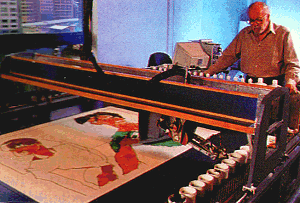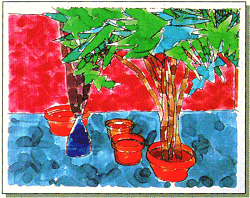
Media and Arts |
 |
| Aaron's robotic arm runs off another masterpiece. Is the human artist obsolete? |
He doesn't have a beret, no ears - and certainly no tank of formaldehyde.
Yet Aaron is every bit an artist. At his studio in Boston, he attracts crowds
to watch him create his latest work. For Aaron is the world's first completely
autonomous painting program - and perhaps the most spectacular effort yet
at endowing computers with that so-elusive spark of creativity.
Aaron is the product of 26 years of research by Harold Cohen, director of
the Center for Research in Computing and the Arts at UCSD the University
of California at San Diego). Cohen began his career as an abstract painter
at London's Slade School, but in 1968, like so many others, he moved to
California and found a new interest -
computers.
Cohen began his research by finding ways to translate his own artistic techniques
into the highly structured computer language used in artificial intelligence
programs.
By 1980, he'd developed a mark 1 Aaron, which was capable of drawing sketches
on a computer screen. Cohen has steadily added more and more sophisticated
concepts - like a knowledge of human anatomy - to Aaron's talents.

The biggest hurdle was to squeeze an understanding of colour - and remember,
we don't even know how humans understand colour - into the straitjacket of
Aaron's symbolic language. Aaron is now 100,000 lines of computer code running
on a Silicon Graphics Indigo workstation. Left to its own devices overnight,
Aaron produces a selection of paintings by morning.
Even Cohen doesn't know what they'll be - Aaron makes them up entirely based
on the rules it has been programmed with. Cohen
chooses his favourite painting, and it is sent to a smaller computer which
controls the robot arm that acts as Aaron's paintbrush. Aaron's repertoire
so far includes still life, figures, and landscapes. Cohen's next step is
to give Aaron's style the ability to evolve: but already some of his pictures
have fetched $2000 in an auction held on the World Wide Web. Who knows what
will happen as Aaron's creativity develops? Perhaps his robot arm might begin
seizing passing animals and dumping them in glass tanks full of preservatives.
See also: Origamibot
Roboticelli
INDEX
![]() Sep95 p17
Sep95 p17